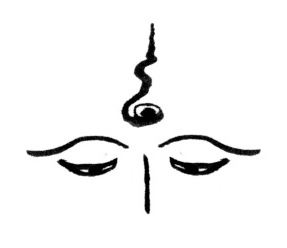For 2013, I suggested to “learn to properly meditate.” The Meditation series on this site lists several posts on meditation, in order to support you in the practical cultivation of such a resolution.
This 2013 suggestion and the associated guidance might still be relevant to most, but for the followers who did embrace it, how to cultivate further? The new suggestion for 2014 is related to the previous one, but takes a different approach. Nibbāna is the highest bliss so it's worth taking as many approaches as may help.
Be present!

Nardia, © Ben Heys
Seeking the end of suffering is not running away from suffering, this is why ‘staying’ present matters.
Blame for one's suffering doesn't work, this is why ‘engaging’ with the present matters.
Being present requires not to be
certain of what's going on; it requires ‘not-knowing.’
It requires to accept the vulnerability and the risk of being wrong, it requires
“leaving
home” in its true sense.
Realising selflessness and impermanence, beyond mere intellectual
notions, supports realisations in relation to duḥkha, the unsatisfactoriness of (present) life arising from
the comparison
to an idealised non-present life and from the clinging to some aspects of
present life but not to others.
Once we accept vulnerability, meditative practices can shatter even the most ingrained habits we used to
identify with and open us up to freedom.
Chopping onions, washing the dishes, or simply looking and looking again, the most mundane activities might constitute opportunities to practise, if you learn how to “be present” to them.
One difficulty though in relation to suffering and the cessation of suffering, ignorance and the cessation of ignorance is that “be here&now” or “don't cling, drop the thoughts” might constitute “valid advice too easily misinterpreted.”
‘Being’ present?
Even the most superficial understanding of the three characteristics of existence will have indicated that ‘being’ present does not relate to some fixed identity but to a creative, balanced process. This is similar to teachings on Nirvāṇa ‘being’ unchanging: these teachings refer to a creative, balanced process.
Buddhism promotes engagement as much as introspection; it promotes both wholesome engagement and wholesome restraint! Buddhism promotes the cultivation of discrimination, when wise, as much as the restraint of discrimination, when ignorant; it distinguishes between ignorant silence and wise silence.
But how can the distinction between wholesome and unwholesome be assessed? How can the distinction between appropriate engagement and appropriate restraint be established? How does this connect to ‘being’ here&now?
The Dharma is both “hard to see” and “clearly visible”. When I promote “helping others and letting go” as “engaging afresh,” I promote disengaged engagement… “Here&now” is thus not naïve, ignorant, “full-on” (i.e. blinded) engagement; but it's continuous or ‘permanent’ engagement nonetheless.
Being ‘present’ to what?
I started by stating that “being present requires not to be certain of what's going on”, and you might have thought: “Wait a minute! If I'm paying attention without prejudices, biases, preferences, then I simply see what's going on, I “see things as they are”, and that's how nibbāna is defined… What does it mean not to be certain in such a context?"
It means… seeing the present consequences of the
past is not enough!
A clear mind not
only never assumes it ‘knows’, but also never assumes it
‘sees’.
To be present is to observe both present consequences of the past and present causes of the future.
Once you let go of the past, how do you learn how to engage ‘wholesomely’? Surely, letting go of the past doesn't imply that you should see the present as merely an inexplicable, intractable, random set of circumstances, unrelated through time. If you imagine yourself as seeing “everything as it is” and then making distinctions (trying to make wise ones) without considering causality (the “hard to see”), your ‘everything’ was in fact ‘partial’!
Here&now is imbued with both present circumstances and present causality. Causality is itself impermanent: identical phenomena labeled as ‘causes’ may generate different ‘consequences’ in various ‘contexts.’ The present is infused with impermanence; present causality is impermanent but causality is also what makes impermanence appear: impermanence is not imposed on the present moment from outside, impermanence co-dependently arises with the moment.
Realising ‘impermanence’ may support the realisation of ‘suffering’ but realising ‘suffering’ may just as well support the realisation of ‘impermanence’; it is important to relax when being present.
Oh dear Brahmā, can you please stop Denis’ ramblings and make him tell us what this means in practical terms?
Whether you practice concentration meditation or insight meditation, or simply
mindfulness in daily life, there is an ‘anchoring’ to the present,
and there is an instruction that you should let go of thoughts and return to
your anchor.
The return might be as soon as you notice you lost focus from your object of
mindfulness (e.g. the breath), or as soon as you notice a loop / clinging
(e.g. after some mental noting, when ideas start fixating and either
“I should remember this” or loops of confirmation biases
begin to arise), but in both cases the instructions rely on
‘anchoring’ (as a tool to “be present”).

third eye, © Denis Wallez
While most people understand this, it is easy to fall into dropping thoughts too fast! A moment is a moment, not half a moment… While you want to cultivate freedom from moment to moment, you also want to ‘extract’ all the wisdom, all the information you can from each moment: this is what allows you to respond ‘appropriately’.
Example of dropping a thought too fast: when anguish arises, one lets it go (immediately or after noting) but without having been present to its causality, without having seen how or why it arose. While such way of letting go will reduce suffering and help relaxation, it is not enough to cultivate wisdom, to cultivate discriminations between wholesome and unwholesome, to get beyond cyclical existence (the anguish will return because its causes have not been addressed).
Example of dropping a thought too fast: if, instead of anguish, a desire to give arises… it is only by being present to the intention (i.e. the cause) behind this desire that one will be able to distinguish wholesome generosity from unwholesome bribery.
There is an intention (of cultivation) behind dropping thoughts during mindfulness practice, and you should not drop thoughts without also being present to this intention: do you drop ‘anguish’ as a tentative to run away from it, or because you realise the emptiness of it and the futility of clinging to it? Do you drop “selfish generosity” because it's selfish or because it's generosity?
So be present to what arises, but also to the causality of the arising! How does the moment arise? How does it cease? Only then, drop the whole ‘moment’. Otherwise, in the name of here&now, you might drop only the ‘consequence’ facet, while ignorantly perpetuating the ‘cause’ facet!
You're cultivating freedom: neither dropping thoughts out of aversion, nor
not-dropping them out of clinging, neither repressing thoughts, nor building
sky-high towers of mental fabrications on top of each other.
Notice (and learn from) the conditions that led a moment of consciousness to
arise, but refrain from building a narrative about the past of these
conditions! Focus on the moment, including moment-to-moment causality but
dropping long-winded stories about past and future.
